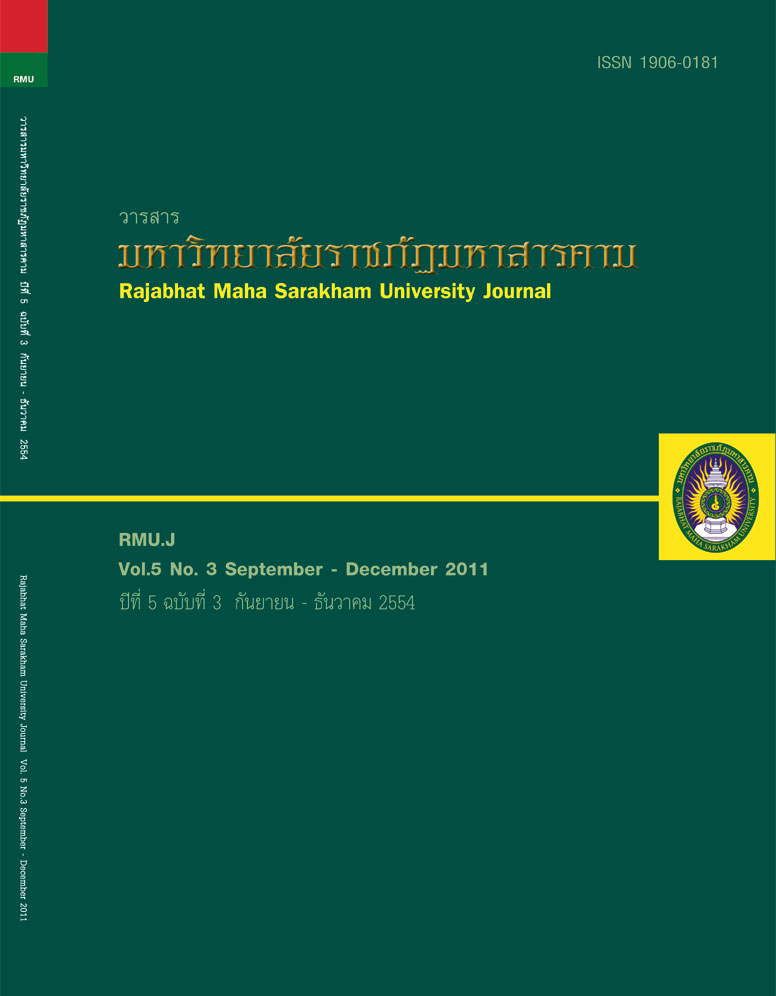การสร้างแบบประเมินความสามารถในการอ่าน คิดวิเคราะห์ และเขียน ของนักเรียนชั้นประถมศึกษาปีที่ 6 สังกัดสำนักงานเขตพื้นที่การศึกษามหาสารคาม เขต 1;Construction of Assessment Instruments on Critical Thinking and Writing Skills for 6th Grade Students under Maha S
Main Article Content
Abstract
การวิจัยครั้งนี้มีวัตถุประสงค์ เพื่อหาคุณภาพและสร้างเกณฑ์ปกติ (Norms) ของแบบประเมินความสามารถในการอ่าน คิดวิเคราะห์
และเขียน ของนักเรียนชั้นประถมศึกษาปีที่ 6 ที่ผู้วิจัยสร้างขึ้น กลุ่มตัวอย่างที่ใช้ในการวิจัยคือ นักเรียนชั้นประถมศึกษาปีที่ 6 ภาค
เรียนที่ 1 ปีการศึกษา 2553 ของโรงเรียนประถมศึกษาในสังกัดสำนักงานเขตพื้นที่การศึกษามหาสารคาม เขต 1 จำนวน 360 คน ได้
มาโดยใช้วิธีการสุ่มแบบหลายขั้นตอน (Multi - stage random sampling) เครื่องมือที่ใช้ในการเก็บรวบรวมข้อมูล คือ แบบประเมิน
ความสามารถในการอ่าน คิดวิเคราะห์ และเขียน มีลักษณะเป็นแบบวัดภาคปฏิบัติการอ่านออกเสียง และการเขียน จำนวน 2 ฉบับ
และแบบทดสอบเลือกตอบชนิด 4 ตัวเลือก จำนวน 45 ข้อ จำนวน 1 ฉบับ นำไปทดลอง 3 ครั้ง การทดลองครั้งที่ 1 จำนวน 50 คน
ครั้งที่ 2 จำนวน 100 คน เพื่อนำผลไปปรับปรุง การทดลองครั้งที่ 3 ใช้กลุ่มตัวอย่าง 360 คน เป็นการหาคุณภาพของแบบวัดภาคปฏิบัติ
และแบบทดสอบวัดความสามารถในการอ่าน คิดวิเคราะห์และเขียน และนำมาสร้างเกณฑ์ปกติ ผลการวิจัยพบว่า
1. แบบวัดภาคปฏิบัติ จำนวน 2 ฉบับ ที่สร้างขึ้น ฉบับที่ 1 มีค่าอำนาจจำแนกตั้งแต่ .82 ถึง 1.00 ค่าความเชื่อมั่นมีค่าเท่ากับ .84
ฉบับที่ 2 มีค่าอำนาจจำแนกตั้งแต่ .75 ถึง .82 ค่าความเชื่อมั่นมีค่าเท่ากับ .77 ค่าความเชื่อมั่นของผู้สังเกตให้คะแนน 2 คน ฉบับที่ 1
มีค่าเท่ากับ .91 ฉบับที่ 2 มีค่าเท่ากับ .94
2. แบบทดสอบวัดความสามารถในการอ่าน คิดวิเคราะห์ จำนวน 1 ฉบับ มีค่าอำนาจจำแนกรายข้อ ตั้งแต่ .29 ถึง .69 ค่าความ
เชื่อมั่นเท่ากับ .89
3. เกณฑ์ปกติ ของแบบประเมินความสามารถในการอ่าน คิดวิเคราะห์และเขียน ของนักเรียนชั้นประถมศึกษาปีที่ 6 มีช่วงคะแนน
ตั้งแต่ T13 ถึง T73
แบบประเมินความสามารถในการอ่าน คิดวิเคราะห์ และเขียน ของนักเรียนชั้นประถมศึกษาปีที่ 6 มีคุณภาพตามเกณฑ์มาตรฐาน
และสอดคล้องกับสภาพจริง สามารถนำไปใช้เป็นเครื่องมือในการประเมินความสามารถในการอ่าน คิดวิเคราะห์ และเขียน ของนักเรียน
ชั้นประถมศึกษาปีที่ 6 ได้;
The objectives of the research were to construct the assessment instruments on critical thinking and
writing skills for sixth grade students, to assess the quality of the assessment instruments and to determine
standard norms of the assessment instruments. The subjects were three hundred and sixty sixth-grade
students studying in the first semester of 2010 in primary schools under Maha Sarakham Educational Service
Area Office 1. They were selected through use of multi-stage random sampling. The research instruments for
assessing critical thinking and writing skills were a reading-aloud assessment form, a writing assessment form,
and a 45-item multiple-choice test. The assessment forms and the test were first examined by 5 experts for
content validity. Then these instruments were tried out with 100 students for improvement and modification,
before they were tried out again with 360 students
Results of the research were as follows ;
1. The discrimination indices of the performance assessment form 1 and 2 were .82-1.00 and .75-.82
respectively. The reliability coefficient of the assessment form 1 and 2 were .84 and .77 respectively. The
Rater Agreemant Index (RAI) between two observers were .91 and .94 respectively.
2. The discrimination indices of the critical thinking and writing skills assessment form were
.29 -.69, and the reliability coefficient of the assessment form was .89.
3. Regarding the standard norm, it was found that the T- score of the critical thinking and writing skills
was T13-T73.
In conclusion, the research findings indicate that the quality of the assessment instruments for critical
thinking and writing skills meets the standardized criteria and is compatible with authentic assessment. These
instruments can then be used to assess sixth-grade students’ critical thinking and writing skills.
Article Details
1. All articles undergo a thorough with at least three reviewers evaluating their suitability within the respective field of study, during the double-blind review.
2. The views expressed by individual authors do not represent the official views of the Editorial Boards of RMUJ: The author of each articie is responsible for all its contents.
3. The Editorial Boards do not reserve the copyrights. but proper citations need to be made.


